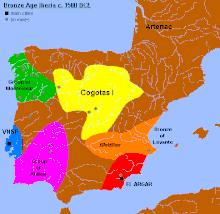Motilla del Azuer
The Motilla del Azuer is in Manchego in Daimiel incurred nuraghenähnlicher stone tower complex from the Bronze Age in Spain .
Motillas (in the plains), Morras or Castillejos (in the mountainous region) are called prehistoric archaeological remains in Castile-La Mancha , which are associated with a culture in the center of the Iberian Peninsula and the Spanish Levant. The so-called Motilla culture with striking similarities to the southern El Argar culture dates between 1700 and 1300 BC. On the La Mancha plain there were in the southern part between 2200 and 1500 BC. Nearly 20 such structures and on the hills in the north more fortified settlements. Their height is usually between four and five meters and the motillas are four or five kilometers apart.
description
The Motilla del Azuer is a round structure about 50 m in diameter that was created using the tholos technique . It consists of a double thin-walled central tower and a large inner courtyard. The walls have a rough appearance. There were few smooth stones. Functionality seems to have been the concern of the builders. The outer walls are inclined inwards. They were built using the cantilever vault technique , a technology of the Los Millares culture and the El Argar culture.
The complex was built for a self-sufficient community with apartments and, strangely, also with a necropolis . There is a 16 m deep well with a spring in the courtyard. Chambers were used for the processing and storage of grain, the production of ceramics and as stables for sheep, goats and pigs. Domed round and oval ovens made of stone and clay were used for cooking. The primary component of all motillas is the central tower. The structure has a diameter of 10 to 11 m at the base and two internal chambers on the lower level. The upper floors no longer exist, but narrow ramps led upwards. All towers were four or five kilometers apart on the La Mancha plain and were in line of sight with one another. From this it can be deduced, but not proven, that they were observation and signal towers that may have formed an early warning system on the plain.
Analogies
This is a similar primary structure as that of the nuraghi in Sardinia at around the same time . From the time the Motilla del Azuer was abandoned, there were other tower-format structures in the western Mediterranean. In the south of Corsica, the Torre culture emerged at the same time as the Nuraghi , and the Talayot culture in the Balearic Islands (though later) . But Scottish brochs are also of a similar construction.
literature
- F. Molina, T. Nájera, G. Aranda, M. Sánchez and M. Haro: Recent fieldwork at the Bronze Age fortified site of Motilla del Azuer (Daimiel, Spain). University of Granada. Antique Vol. 79 No. 306; 2005.
- Michael J. Kolb: The genesis of monuments among the Mediterranean islands. In: The Prehistoric Archeology of the Mediterranean. In: BA Knapp and E. Blake (eds.) Insularity and island identity in the prehistoric Mediterranean Blackwell, London, pp. 156-179, 2007.
Web links
Coordinates: 39 ° 2 ′ 35.9 ″ N , 3 ° 29 ′ 50.7 ″ W.
